Exclusive: The Secret Restoration Of The Big Ben Clock In The Lake District
David McVicar paining the temporary arms of Big Ben clock at the Cumbria Clock Company. Credit: Simon Camper/Lumen Photography
9 min read
A tiny Lake District village kept one of Britain’s most precious national symbols safe and sound for three years, hidden from view in a converted cow shed. Now the Big Ben clock has made its return to Westminster, Kate Proctor meets the restoration team that gave the 162-year-old timepiece a new lease of life and are taking us a step closer to hearing the famous chimes once again.
It’s got all the ingredients of a thriller, except the “asset” at the heart of the tale is not a Cold War spy but a clock. This isn’t just any timepiece, however, it’s the most famous clock in the world, colloquially known as Big Ben after the giant bell it powers.
Such was the security around protecting this treasured national symbol that Keith Scobie-Youngs of the Cumbria Clock Company launched a covert operation to protect it. In an unassuming stone barn overlooking the Lakeland fields with only sheep and ramblers for company, he and his restoration team toiled away in secret for three years.
To deter criminals, they removed all their signs from the village of Dacre, in the heart of the Lake District, so if the worst happened and word got out, those with nefarious intent would have a tougher time finding them.
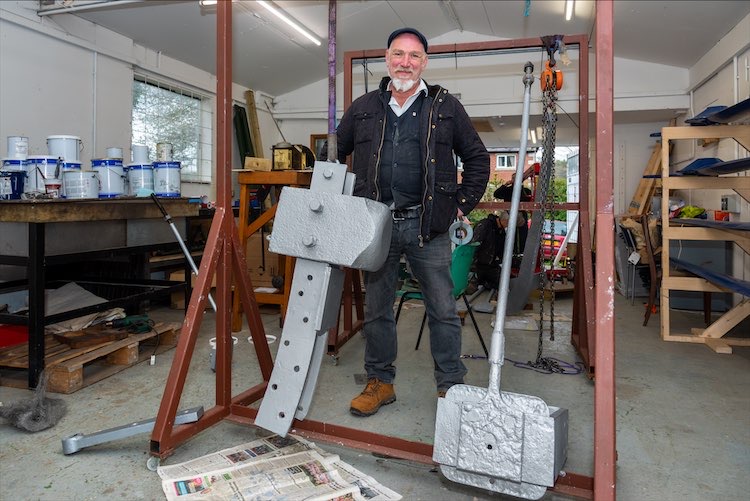
Keith Scobie-Youngs with the Big Ben bell hammer head (Credit: Simon Camper/Lumen Photography)
Parts of the mechanism and clock arms were transported across the country at odd hours of the day and night. Most important by far to keeping the work under wraps were the neighbours, who formed an unofficial watch on the firm’s workshops, letting Scobie-Youngs know if anything looked suspicious. For three years their secret was pretty much safe.
The only close moment came when some walkers suddenly appeared at the window of the barn, noses pressed against the glass, staring straight at the clock which was by this point fully set up and ticking away in the test room. They’d heard from somewhere that “Big Ben was in the barn” and came over to have a look.
“I just said, it’s not what you think it is,” said Scobie-Youngs, laughing about how he fobbed them off with a story about another clock he was working on. Very smoke and mirrors.
“And as they left they said ‘oh yeah, I didn’t think so either…’.” Stories do get out, but in all the years we’ve been involved in the project, apart from those walkers, nobody out of the blue just knocked on my door or drove down the track to ask.”
He is full of praise for his “brilliant” neighbours and the local community in Dacre who helped the team get on with the job.
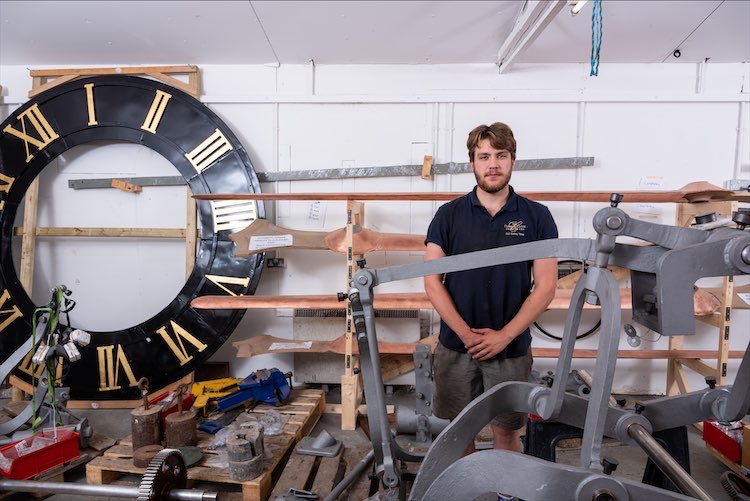
Callum Scobie-Young with the fourth bell’s quarter hammer in the CCC workshops (Credit: Simon Camper/Lumen Photography)
“Everybody in the village knew the clock was here. I didn’t go out of my way to hide it, because it was going to get out. And so when people said, have you got Big Ben’s hands in there? I’d say, ‘Yeah, we’ve got to keep this secret.’ People would say ‘no worries, no worries’.
“I think they had that sense of pride, sense of responsibility. They didn’t want the world’s most famous clock stolen while in the village.”
There has also been satisfaction that such skilled work came to the area, with local apprentices who recently studied at local schools in Penrith and Keswick working on the project right through to the most senior clock restorers, with 30-years’ experience each, including Scobie-Youngs himself and David McVicar, who retired last year. Fourteen of the company’s 21 staff are based full-time in Cumbria, including Scobie-Youngs’ two sons, Callum and William.
“I think people are pleased. Usually with these massive projects from London, how often does it benefit the Lake District? And this is one which has and I think will continue to do so,” he said.
The Elizabeth Tower which houses the clock and the largest of the five bells that make the world-famous bongs of “Big Ben” has been covered in scaffolding since 2017 as part of a major £80m restoration project. Everything is being repaired, from the gilt cross and orb at the top to its 334-step staircase. Some of the major changes announced already include restoring the original paint scheme from 1859 chosen by the tower’s Victorian Gothic architect Charles Barry, so the black dials and clock hands are now in the original Prussian blue. Temporary hands that were on the clock for more than two years were also made and decorated by the Cumbrian Clock Company, which Scobie-Youngs founded with his wife Lynn in the 1990s. Part of the agreement of the restoration contract was that one of the four faces needed to be exposed throughout.
“All of a sudden, to have the workmanship of everybody here at the company being the most photographed thing in London, and not being able to say anything about it… you couldn’t help feel like, if only you knew!” Scobie-Youngs says.
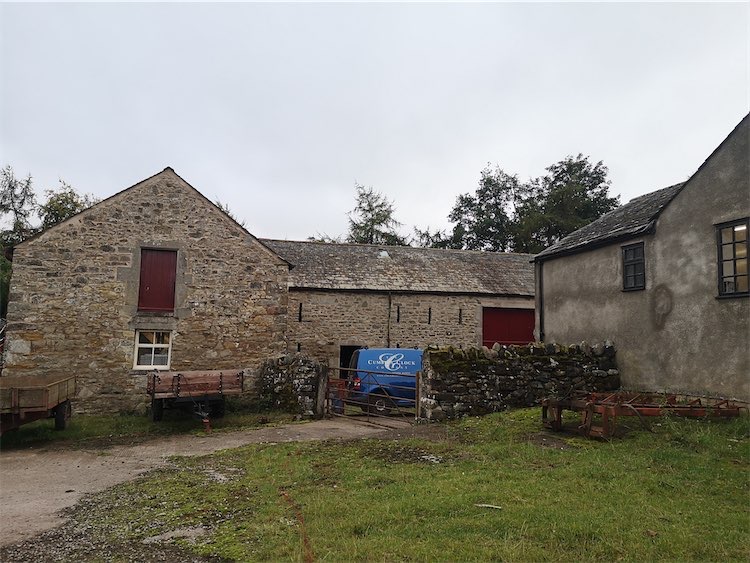
Cumbria Clock Company (CCC) based in Dacre, Cumbria
In 1846, the competition to design the clock for the tower was fierce – and demanded nothing short of a horological revolution: a clock that could keep time within one second a day. It was also to have the largest dials in existence and be the most accurate chiming clock in the world.
Scobie-Youngs, who learnt his craft at Birmingham Polytechnic in the early 1980s, said the largest dials in London up until then were St Paul’s Cathedral’s, at 12 feet.
“And so all of a sudden there’s this design of dials which were 23-and-a-half feet in diameter, and the remit that this clock should keep perfect time within a second a day.
“All the great turret clock makers of the time [were competing] and Benjamin Lewis Vulliamy, who was the most important clock maker at that time, automatically thought he would get the job. He did the designs, but it was put out to tender and Edward Dent won the contract; and working with him and Edmund Denison, [was] later Lord Grimthorpe.”
Grimthorpe designed the mechanism, with George Airy, the astronomer royal. Construction was down to clockmaker Dent, but he died in 1852 before seeing it completed. The work passed to his stepson, Frederick Dent.
“They designed Big Ben, they designed the escapement, the middle part, the regulating part of the clock that could keep the clock to a second a day. That revolutionised public timekeeping. And we have this clock now which does still keep, after 160-years-service, time to within a second a day. And it’s all mechanical, not electrical, it doesn’t rely on GPS.”
He laughs: “So if all the satellites fall out of the sky, Big Ben can still keep time.”
The clock is made from cast iron, which was novel for the time, and parts of it are extraordinarily heavy. The quarter barrel comes in at 860 kilograms – the weight of a small car. The method of construction was so precise and the clock so well made that many of the 160-year-old parts still look brand new.
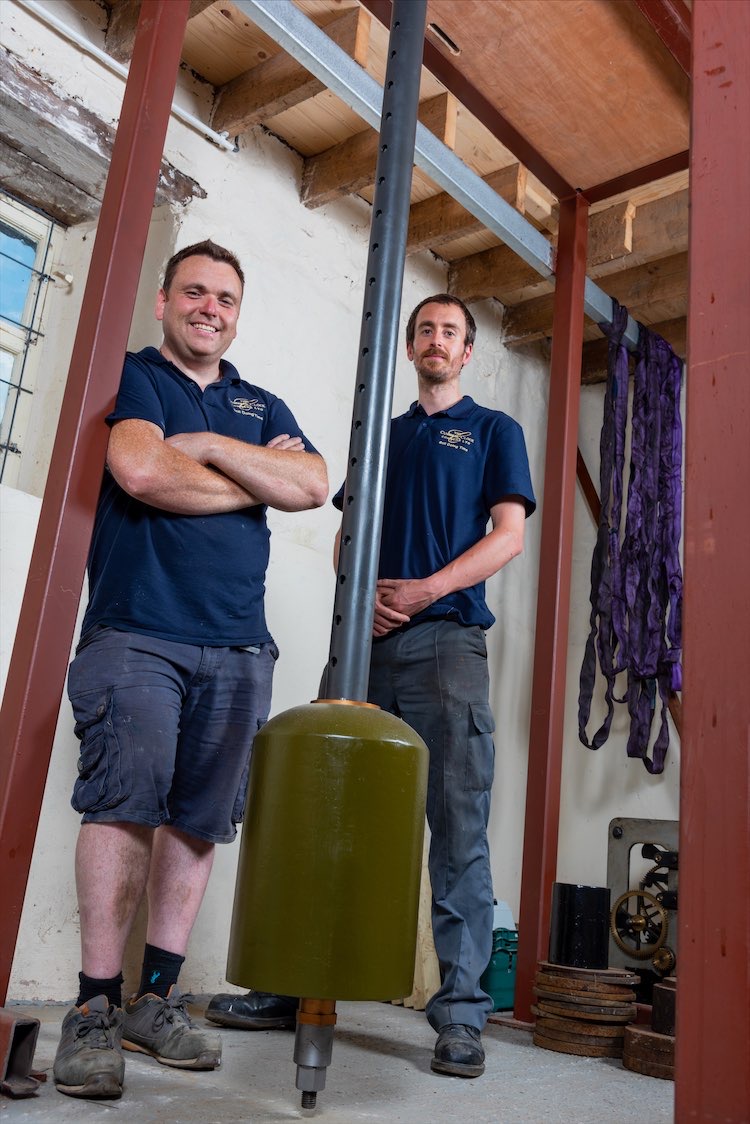
Mark Crangle and John Maher standing next to the pendulum of the Great Clock on test in the CCC workshops (Credit: Simon Camper/Lumen Photography)
Due to Big Ben’s symbolism and mystique, along with its public service function as a highly accurate clock, previous repair jobs have by necessity been rushed, to minimise stoppage time.
This time, the Cumbria Clock Company got the time and space to do a thorough job. “You have to have in mind that this was such an important clock it couldn’t be stopped [for long]. And if it stopped, the important thing was to get it up and running again. So repairs were very much on the hoof.
“Those repairs weren’t poor workmanship, but the necessity [was] to get the clock going. We’ve not refinished anything, polished anything or re-grained it or re-machined it. It’s now just very, very clean and newly protected so it’s still going to be in good condition in 70-years-time, at least.”
Handily for future generations, Scobie-Youngs has left several manuals, videos, drawings and training guides for the clock to explain exactly how it works. He could have done with such assistance himself – there were no drawings passed down the generations for him to use.
His only reference was A Rudimentary Treatise On Clocks And Watches And Bells written by Grimthrope a few years after the clock was installed. This proves the extraordinary skill and ingenuity of clock makers called to work on Big Ben at short notice, who had to figure out things for themselves. That includes Scobie-Youngs’ much respected former “gaffer” John Vernon, who he worked for in London when he was in his 20s.
“He was the chap who rebuilt the clock when it broke down in ’76 – the explosion of the mechanical clock. “He was never recognised for the work he did,” Scobie-Youngs says.
That “explosion” was in fact the quarter barrel careering through the air and smashing up some of the mechanism. Had it not been encased in its own room, it could have easily spun out of the tower wall, such was the force behind it. Police in Westminster at the time thought a bomb had gone off.
“Vernon had a short period of time to recover [it] and saved it. Without him, we could have been looking at an electrical clock up there from the 1970s, and lost this massively important piece of turret clock horology. But because of John’s talent, skill, belief, and pure doggedness, he got it back up and running in time for the Queen’s Silver Jubilee in 1977.”
“For me to be able to follow in his footsteps now is quite remarkable.”
Scobie-Youngs says he’s found John’s signature here and there on very discreet parts of the clock – something clockmakers tend to do.
With a twinkle in his eye, he said: “I couldn’t say if I’m going to do that or have done it myself.”
In another nice historical link, Scobie-Youngs got to use one of Dent’s original spanners to fix the clock.
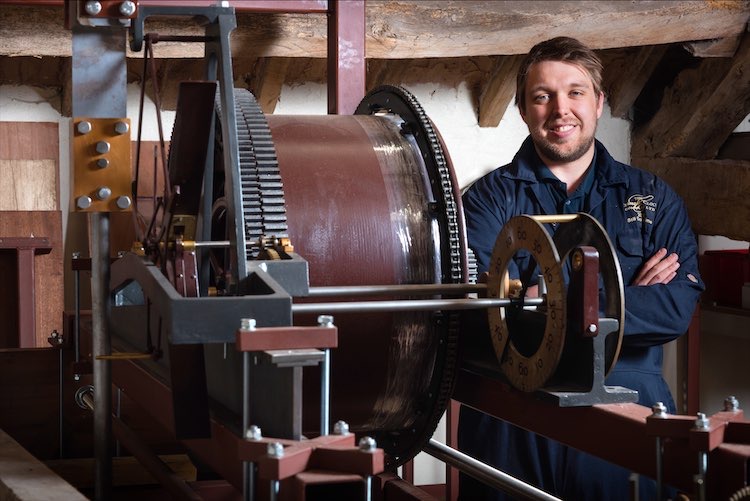
(Credit: Simon Camper/Lumen Photography)
The next task is for some of the team to head back to London to start the daunting reassembly job back in the Elizabeth Tower. Eventually they need to get the clock connected up to the bells so the chimes can start once again. There will be stoppages as part of the testing process, he warns. The ticking should kick into life at the end of the month, all going well, then the rest depends on getting access to the weight shaft.
“I think the new year is when I’ll see the whole mechanism, working as it was originally meant,” Scobie-Youngs says.
But nothing will stick in the memory quite like hearing the tick in his own rural workshop in Dacre.
“Big Ben has got such a distinctive tick that we used to go and say to each other, ‘we’re going to go listen to the heartbeat of the country’.
“You’re used to hearing it in Westminster [in the clock tower] and then all of a sudden, you hear it in the test room here. You can’t help but feel immense pride.”
Photographs: Simon Camper/Lumen Photography.
